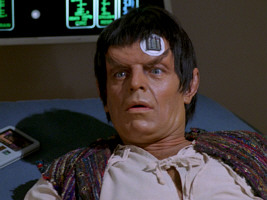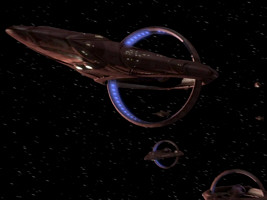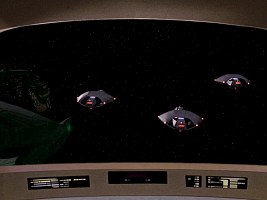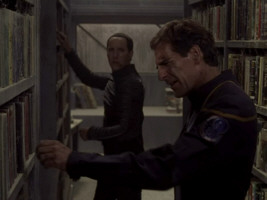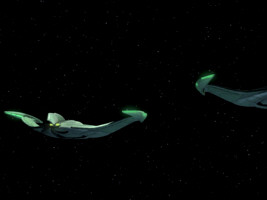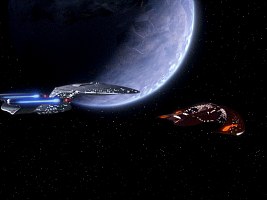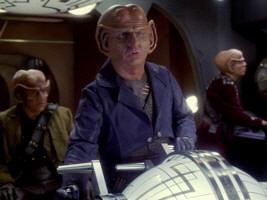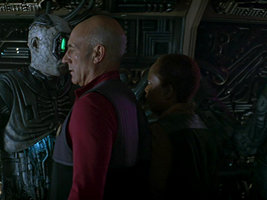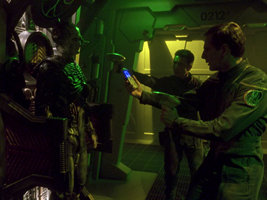Enterprise Continuity Problems
"Dear Doctor" and the Prime DirectiveEarth and Starfleet VulcansRomulansFerengiBorg
"Dear Doctor" and the Prime Directive
by Luther Root
"Some day, my people are going to come up with some sort of a doctrine, something that tells us what we can and can't do out here, should and shouldn't do. But until somebody tells me that they have drafted that directive, I'm going to have to remind myself that we didn't come out here to play god." (Jonathan Archer)
The episode ENT: "Dear Doctor" recommends itself as the origin of Starfleet's Prime Directive (PD). There are, however, doubts whether the Prime Directive (if it had already existed) would really have been broken if Archer had given the Valakians warp technology or the cure for their illness.
The Prime Directive is defined (albeit in a non-canon source) as "the right of each sentient species to live in accordance with its normal cultural evolution is considered sacred, no Star Fleet personnel may interfere with the healthy development of alien life and culture. Such interference includes the introduction of superior knowledge, strength, or technology to a world whose society is incapable of handling such advantages wisely. Star Fleet personnel may not violate this Prime Directive, even to save their lives and/or their ship unless they are acting to right an earlier violation or an accidental contamination of said culture. This directive takes precedence over any and all other considerations, and carries with it the highest moral obligation." Ref: Star Trek: The Next Generation First Year Sourcebook.
When courts interpret legal statutes, they do not rely on the literal meaning of the legislation in question, but rather ask themselves, what is the *purpose* of the legislation itself. By applying this reasoning, if the raison d'être of the Prime Directive (PD) is non-interference in the evolution of a species, one could argue that there would be no breach of the PD (even if it existed) in this instance, because the Valakians consciously attempted to contact another species, had the means to do so, and were indeed successful in doing so. Therefore it is argued, they were willfully controlling their own destiny and the course of their own evolution. It is clear, the Valakians devised a scheme to safeguard their own existence, namely to acquire a cure through another species, or in the alternative, seek to acquire warp technology, which would ultimately lead to finding other species that could. It only stands to reason, that if they are *sufficiently advanced* to act upon this plan, and carry it out successfully, then why should they be seemed unworthy of its reward. From this point of view, the Valakians are controlling their own evolution, and there is no "interference", as such. (Compare this with the context in which "interference" is used in the PD) This situation differs markedly from one, where the Enterprise clandestinely sends an away mission to the Valakian homeworld, discovers the existence of the ailment, and then volunteers a cure.
There is also the question whether the PD applies at all, in light of the fact the Valakians were contacted by two other warp-capable species. Whilst, the nature of their meetings with the Ferengi, and the M'klexa remains unclear, one can reasonably posit that these encounters would have encouraged the Valakians to seek out another species, to either find a cure, or to obtain warp technology from. This would have the effect of diverting resources away from conducting their own research and development for a cure, instead directing them to developing an interstellar space travel program. Consequently, this would alter the probability of them finding a cure domestically, and place a greater emphasis on finding it through means of another species. So in essence, their culture was already irrevocably "contaminated", by two other warp-capable species, and its development has consequently changed, as a result. This is explicitly stated in the Prime Directive itself. Therefore, if the Prime Directive is breached once (by any race), then its application should cease to be relevant for all races. This brings into light the issue of warp capability, with respect to the PD. Warp capability only becomes relevant, because it is regarded as a prerequisite for contacting other species, or conversely, the ability to travel FTL means that contact with another species, is inevitable (at least in the Trek Universe, it does). However, in the case of the Valakians it was merely sufficient for them to leave their own system to contact another species, which is an achievement in itself (by our standards, anyway). Therefore, warp capability should only be viewed as measure of the ability to contact other species, and not a yardstick of worthiness of association. Indeed there is absolutely no reference to warp capability in the Prime Directive. Finally, since the Valakians were successful in contacting another species, on what basis should they be deprived the cure? Indeed, once the cure is developed, it could be argued that depriving them of it, constitutes a breach of the Prime Directive itself, since it is Archer *himself* who is determining the next course of evolution for the Valakians.
Other things to consider: The distinction between treatment, and cure, was grossly over-simplified in this episode. Merely providing any medical treatment may potentially have the same repercussions on the evolution of both species, in a similar way to a providing a cure would. Phlox talks about evolution, as if it is preordained. Clearly it is not.
Earth and Starfleet
Nation states
With only infrequent exceptions, all crew members of Enterprise, all other members of the human species, all places on Earth mentioned and any human food or custom is explicitly or tacitly assumed to be American or of British or Irish descent. Irrespective of the real-world reasons for this Amerification of the series, Enterprise creates the impression that, as of 2151, nation states still exist and that the USA is the all-dominant country, the only one able and willing to go out into space and encounter aliens. Differences between cultures on Earth are only hinted at in ENT: "Shuttlepod One", ironically along with Trip's condescension that exclusively Americans developed the warp drive. The dominance of the USA poses the question if this is consistent with established Star Trek history or even with what is stated in Enterprise itself.
By 2150 all countries had joined a United Earth Government (TNG: "Attached"), hence nation states seem to have been abolished. Perhaps they still have some degree of sovereignty. But if anything, they have a common space program. This is obvious not only because of the immense costs that could be shared, but also because the still existing nationalism may be overcome much easier in space than on Earth, where nation states may still struggle for territories and resources, only now without violence. Even in present day, common space projects from the Apollo-Soyuz mission to the ISS always proved to be something that ties humanity together and helps to forget conflicts on Earth, and if only temporarily. It seems implausible that it could be the other way round in the 22nd century. In particular, the encounter with aliens, namely the Vulcans, must have played an important part in Earth's progress from a battered planet to a society without war, hunger and disease, as mentioned in "First Contact" as well as ENT: "Broken Bow". No matter if the Vulcans helped actively or only provided the incentive for humanity to rebuild their society, it wouldn't be plausible, much less fair or desirable, if only America profited from it and became (or remained) the all-dominating economic, military and cultural force in this process.
The basic setting of Enterprise, in strong contrast to the statistically prevalence of American names of individuals, ships and places, rather confirms the idea of a united Earth than of a dominating American nation state. Actually, whenever crew members of Enterprise refer to their own group (to T'Pol, Phlox or other aliens), they always speak of themselves as "humans" and "Earth". "Americans" are mentioned only occasionally in the sense of a country or particular group of humans, and only once notably when Tucker talks to Reed about the work on the warp drive as a solely American achievement. Irrespective of the intentions behind the American predominance in the series, I think it is odd if not hypocritical to refer to "humans" while meaning "Americans". Well, Neil Armstrong said "One small step for a man, but a giant leap for mankind", not mentioning his country either. On the other hand, it was a US flag and not one of the UN that he planted on the Moon. The situation must be definitely different at the time of Enterprise. Unless we are ever told otherwise, there is no reason to doubt the clear statements that the conflicts on Earth, and in particular any form of Cold War, have eventually been overcome. It should have been a matter of honesty to fulfill Enterprise's premise of a united humanity and show the required diversity first of all in the form of foreign crew members (rather than token non-Caucasian characters who are tacitly assumed to be American citizens as well).
Human exploration and colonies
The premise of Enterprise, as it was expressed several times in ENT: "Broken Bow" and other episodes, is quite clear: Human ships have never been very far away from the Sol system. Archer explicitly states that no human has ever been as far away from Earth as Risa (90 ly, "Two Days and Two Nights"), although there may be single, unofficial journeys he doesn't know of (as he later conjectures about the human body found at 100 ly distance in "Future Tense"). What's more, humans don't know most of the neighboring alien species. Even the Andorians, who can be found in the vicinity of the Vulcan star system ("The Andorian Incident"), are unknown to humans until 2151. The location of Vulcan has been conjectural for a long time, with fans widely accepting 40 Eridani-A, a star system with a habitable zone at a distance of about 16 light years from Earth. In "Home" exactly this distance is ultimately confirmed. Human ships achieve speeds of typically Warp 1.8 ("Fortunate Son"). This all points to a radius of human exploration of at most 20 light years as of 2151. At Warp 1.8 (old), such a distance could be covered in no less than three and a half years.
The most obvious evidence for the human range of exploration is Terra Nova. As explicitly stated in the episode, the planet is 20 ly away from Earth, and it must have been the closest known Class-M world at the time. It is already incredible how humans, without any help from the Vulcans, could launch a fully-fledged colony ship for a nine-year trip only four years after Cochrane's home-made prototype. But it would be idiotic if they picked a planet 20 ly away if they knew of any equally suited but closer destination (perhaps Alpha Centauri was not yet terraformed or posed other risks?). It is yet another unbelievable fact (curious as humans are!) that no one bothered to return to Terra Nova in 70 years, but this is a sign that perhaps human ships have never reached any destination more than 20 ly away from Earth.
Maybe humans have been traveling on alien ships as "hitch-hikers" on a few occasions. However, we know that at least the Vulcans are opposed to that and we can imagine that most aliens wouldn't be exactly keen on transporting human settlers to colonies that they might want to claim for themselves. This is already the first major problem of the premise. How could humans, being newcomers among many species that are more advanced, possibly find any suited planets for colonies within the limited range of their ships? It is already very fortunate that no evil aliens ever raided Earth on a larger scale than the Briori mentioned in VOY: "The 37's", but at least this may have been prevented by the Vulcans and other benevolent species. Enterprise NX-01 with its top speed of Warp 5 may have considerably enlarged the range of exploration and subsequently of colonization. 100 ly distance may be bridged in less than a year at that speed. But considering that there are already dozens of more advanced species we know of inside this radius, it seems unlikely that any Minshara-Class planet would remain unoccupied.
On the other hand, aside from Terra Nova we have already seen quite a few inhabitable but uninhabited planets on Enterprise's journey, like "Sluggo's" old and new worlds from "Fight or Flight", the planet from "Strange New World" (the spores may have been an obstacle, but would not prevent a colonization on long terms), the "Oasis" planet and the "Precious Cargo" planet. Maybe humanity was lucky that most other civilizations, unlike the Romulans in "Minefield", were not out for colonization, or there are really enough Class-M planets for everyone, if we go with the unlikely presumption that most stars have inhabitable zones and at least planets that may be easily terraformed.
Another problem is that there are supposed to be human colonies at all if it was never attempted to reactivate or only to reach Terra Nova in 85 years. Admiral Forrest mentions the Vega Colony in "Future Tense", and in "Twilight" we learn that there is another one on Alpha Centauri. Alpha Centauri is an obvious choice because it is very close, but Vega is a star about 23 light years away from Earth, obviously a slightly longer distance from Earth than Terra Nova. The only complete explanation would be very contrived. Vega would not be the real star of that name, but a closer one that has been terraformed, or on which a pressurized environment was set up. But it is still possible that there are reasons not to go back to Terra Nova we don't yet know of. This might include hazardous environmental conditions in the Terra Nova solar system, or hostile aliens that would have posed a threat to any human ships in that region, but who, for some reason, were not interested in the planet itself.
Vulcans
Mind melds
For decades the capability of mind melding has been a defining quality of the Vulcan species and society. Vulcans performed mind melds in all four series preceding Enterprise, most frequently Spock in TOS and Tuvok in Voyager. The question whether this was morally correct or whether a particular Vulcan was capable of mind melds at all never occurred until Star Trek Enterprise. But in ENT: "Fusion" and ultimately in "Stigma" mind melds are suddenly shown as indecent and additionally as something that only a small fraction of the Vulcan population could do at all. This goes along with a tendency during the first three seasons of Enterprise not to depict the 22nd century Vulcans as the usually benevolent and peaceful people that we know from the 23rd and 24th centuries.
The statements made in "Fusion" and "Stigma" establish a cultural and even a biological inconsistency, respectively. Many fans were inclined to accept the alleged low percentage of "melders" though - they saw continuity preserved because no one ever literally said "All Vulcans can meld their minds". Fortunately with the Vulcan trilogy in the fourth season this misconception is eventually refuted, and Enterprise is skillfully reconciled with the rest of Star Trek. All Vulcans are capable of mind melds, and everything indicating a low percentage of "melders" (and thereby ostracizing them) was a lie. Read the complete analysis on a separate page.
Vulcan fleet and technology
As of 2152, the Vulcan fleet is among the strongest and best equipped of the known universe, probably on par with the Klingons. On one hand, this is realistic, since it would be the only way to protect Earth and possible other backward worlds from hostile races (but not from the Xindi, obviously). It would also fit with the latent violence and paranoid obsession with security that Vulcans consistently exhibit in Enterprise. On the other hand, the question occurs what will become of the mighty Vulcan fleet after the Federation is founded. 100 years later it seems to have vanished without a trace. In addition, later Starfleet ships look nothing like Vulcan ships, but a lot like Enterprise NX-01, a solely human development and in every respect inferior to Vulcan designs of its time, as we can witness several times, for instance in ENT: "Breaking the Ice" or "Fallen Hero". With the notable exceptions of Spock and entirely Vulcan crews like that of the Intrepid in TOS: "The Immunity Syndrome", Vulcan crew members don't seem to play any role in a mostly human Starfleet either (this will change again a bit until the 24th century). What's more, with the Vulcans having technology from cloaking to tractor beams well before the humans, it worsens the problem of the missing progress from 2151 to 2264. It seems that the Vulcans, even after they had joined the Federation, continued to keep all these technologies for themselves, and that their secrets have vanished together with their ships, or needed to be gradually re-developed by a human-dominated Federation and Starfleet.
It seems we have to combine several theories to explain the disappearance of Vulcan ships, crews and technology. For once, we already know that the Vulcans of the 22nd century were reluctant to share their technology, as no one could express it better than Archer (for instance, several times in "Broken Bow"). If the Federation was a loose alliance like the present-day UN at first, it becomes plausible that the Vulcans would neither want to bring in their ships nor their technology in a way that Earth or even the Andorians could profit from it. Towards the end of the 22nd century the rest of the Federation might have reached the same technological level as the Vulcans. This, however, would be only one more argument for the Vulcans to keep their own fleet in service for an even longer time after the foundation of the Federation. Maybe the Vulcans lost interest in maintaining their own fleet, seeing that humans and the rest of the Federation had caught up with them in the fields of science and exploration.
An even more plausible explanation is that the removal of V'Lar from power and the discovery of the Kir'Shara as seen in ENT: "Kir'Shara" had a lasting impact on the Vulcan policy. The Vulcans may have withdrawn from many exploratory missions and concentrated on working on an improvement of their society and of themselves. This is the clarification we have to apply anyway to explain why the Vulcans of the 23rd century and 24th century are generally so benign compared to the Enterprise era.
Side note It is also possible that at some point the Vulcans suffered a disastrous defeat and were not interested in rebuilding their fleet. In this regard it appears plausible that it may have taken until the mid-23rd century that single Vulcans like Spock joined Starfleet. The Intrepid from TOS: "The Immunity Syndrome" (usually listed as Constitution class) could have been a Vulcan design, as we have never seen the ship. The name is strong evidence against this suggestion though.
 The Lower Decks episode "wej Duj" shows a big and powerful Vulcan ship at the end of the 24th century, the Sh'vhal, which is arguably over 1 kilometer long. The Sh'vhal is either an exception, or we may have to re-evaluate the idea that the Vulcans may have given up their fleet. We also learn that the Vulcan High Command is still or again in charge of their space operations.
The Lower Decks episode "wej Duj" shows a big and powerful Vulcan ship at the end of the 24th century, the Sh'vhal, which is arguably over 1 kilometer long. The Sh'vhal is either an exception, or we may have to re-evaluate the idea that the Vulcans may have given up their fleet. We also learn that the Vulcan High Command is still or again in charge of their space operations.
Romulans
The name "Romulans"
We know from TOS: "Balance of Terror" that the look of Romulans is unknown to Starfleet as of 2266, the explanation being that the peace treaty of 2160 was negotiated with a voice-only subspace connection. The episode ENT: "Minefield", taking place in 2152, sticks to the established history, and no visual contact is established with the Romulan vessels. Likewise, human crew members only see the mystery ships in the trilogy ENT: "United", "Babel One" and "The Aenar" but not the Romulan officers who operate them via remote control from Romulus. So far Enterprise maintains continuity, although it was never quite credible that humans wouldn't meet Romulans face to face in more than a hundred years.
The first mention of the Romulan Star Empire is in ENT: "Shockwave, Part II", where Archer reads it on a book in a future library. So it even predates the first encounter in "Minefield". The names of the planets Romulus and Remus (TOS: "Balance of Terror", "Star Trek Nemesis") are quite unmistakably of human origin. So it would have been obvious if a human astronomer, perhaps one with a predilection for ancient Roman history, had discovered and named the planets, before it was even known they were the home to an alien civilization. Naming these people "Romulans" would have been a logical choice, especially if the aliens should not refer to themselves with a name that humans could easily pronounce (in the same fashion as the humans don't call the Vulcans by their indigenous name). Referring to Romulan ranks as "Praetor" or "Centurio" could have been a further consequence.
In "Minefield", however, it is T'Pol who pulls the name "Romulans" from a Vulcan database. So whether they knew the Romulans were their descendants or not, the Vulcans came up with a human name for another alien civilization? This does not make sense at all, unless we apply a good deal of additional conjecture. What T'Pol said may have been some Vulcan word that sounded to humans like "Romulan", and some human cartographer with a fondness of Roman culture may have decided that their planet should be Romulus, and the neighbor planet accordingly Remus. Or T'Pol quickly made "Romulans" as a reference to the already existing human planet name "Romulus", although such creativity seems quite unlikely. The error of the Vulcans coming up with a human name is not the first in the series, however. Already in "Broken Bow" the star system of Rigel was found in a Vulcan database, and both Hoshi and Archer were unaware of the existence of this quite prominent star in our night sky.
It would have been a much more intelligent idea to have Archer come up with the name "Romulans" in a kind of predestination phenomenon. He reads about the Romulan Star Empire on a book in "Shockwave", and when Enterprise runs into unknown vessels in "Minefield" that perhaps look similar as a depiction on that book, he surmises that these should be the Romulans. Now that would have been a great twist!
Design & technology
The Romulan ships encountered in "Minefield" look similar as the Romulan Bird-of-Prey more than 100 years later. The former lack the bird painted on the bottom though, although in TOS: "Balance of Terror" it was stated to be a distinguishing mark of Romulan ships of the time to have this depiction. Actually, the Art Department originally included the typical bird painting, but they were asked to remove it.
On a different note, the ships in "Minefield" already have cloaking, although this will be a huge surprise over 100 years later in "Balance of Terror". This is sad especially since the plot of "Minefield" wouldn't have required cloaked ships at all. The mines were cloaked too, but apparently using a less advanced technology that left possibilities to detect them. Another thing that has been labeled by some fans as a problem of Minefield is actually a non-issue. It is absolutely logical for the Romulans to have warp drive in the 22nd century.
Ferengi
In ENT: "Acquisition", first contact with the Ferengi is predated by no less than 213 years when a group of Ferengi raid Enterprise. This is a continuity problem regardless of the lame trick not to mention the word "Ferengi" in the whole episode.
In 2364, the Ferengi are unknown to Starfleet, as becomes obvious in Picard's negotiations with Administrator Zorn in TNG: "Encounter at Farpoint":
Zorn: "Captain, the Ferengi would be very interested in a base like this."
Picard: "Fine. I hope they find you as tasty as they did their past associates."
Picard apparently doesn't know anything about them, and he just cites a myth or quickly makes up one in a lack of better ideas. In the same episode, an unknown ship (actually the second "jellyfish") enters the star system, and Picard suspects for a moment that it could be the Ferengi.
Also, Picard points out very clearly in his logbook entry in TNG: "The Last Outpost":
"We are in pursuit of a starship of Ferengi design. Our mission is... to intercept and recover a T-9 energy converter which the Ferengi stole from an unmanned monitor post on Gamma Tauri IV - a theft which automatic scanners recorded, providing us... with the long awaited opportunity to make close contact with a Ferengi vessel. If we succeed in this chase, it will be Starfleet's first look at a life form... which, discounting rumor, we know almost nothing about."
This statement does not exclude that single individuals, a Starfleet vessel, or maybe Starfleet Intelligence may have had "unofficial" encounters with the Ferengi before. The Federation may know how the Ferengi look like, and if only because of the scanner records from Gamma Tauri IV.
Side note There is still another problem with the real star system Gamma Tauri, which is located at the opposite side of Federation space if we assume that Ferenginar must be rather close to Deep Space 9. Of course, the DaiMon is silly to claim that the planet should belong to the Ferengi, but the question remains how and why they crossed the complete Federation space to get there.
The knowledge about Ferengi technology is only hearsay, as the dialogue from TNG: "The Last Outpost" proves:
Riker: "Anything on that design, Data?"
Data: "Nothing specific, sir. As you know, Ferengi technology is estimated to be generally equal to our own..."
Picard: "Which does not mean identical, however..."
Data: "Correct, sir. We are no doubt advanced in some areas, they in others..."
In TNG: "The Battle", Data mentions an encounter Picard had with a Ferengi vessel in 2355 which was, in accordance with what had been established about the Ferengi in "The Last Outpost", unidentified at the time. DaiMon Bok is upset about the ship being "unidentified", and he insists on it being a Ferengi vessel.
In "Star Trek Generations", Data recalls and gets the meaning of a joke from the Farpoint mission seven years ago, before the Enterprise actually encountered a Ferengi vessel. The punchline involved a "Ferengi in the gorilla suit". However, it is simply impossible to make jokes about someone or something that is unknown. There must be already some concept of the Ferengi, and if only a preconception, for a joke about them to make sense. Nevertheless it is still possible that the Ferengi are commonly talked about among Starfleet officers of the time just because they are so mysterious.
Another fact that needs to be taken into account is that Quark opened his bar at Terok Nor before the Federation made official first contact with his people. He left Ferenginar in 2351 (DS9: "Family Business") and must have arrived at Terok Nor some time before 2360. Considering that Terok Nor must be close to the border of the Federation (we may assume that Starbase 375 or a smaller outpost already existed during the war with the Cardassians), Starfleet may already have known more about his race prior to 2364. On the other hand, the war with the Cardassians may be exactly the reason why Starfleet was not able to gain more extensive knowledge of them if their homeworld was located somewhere behind the lines.
Side note With Terok Nor being close to the Federation border and Ferenginar being close to Terok Nor there is still the question why the Federation did not get to know the Ferengi before or even during the war with the Cardassians. Long-range ships of both the Ferengi and the Federation should have been able to reach the other side already for a long time, even if they had to circumvent Cardassian territory. Even during the Dominion War the Federation was always in contact with the Ferengi.
Also, in DS9: "Playing God" Jadzia mentions a black hole to Arjin, a Ferengi drink that a "bartender I've known for a hundred years" introduced to Curzon. That may have been just a few years prior to the episode when Curzon was still alive. Jadzia then wonders whether it could have been Lela instead of Curzon, but Lela was the first Dax host and lived hundreds of years ago, so this possible mix-up sounds much like a joke.
Ferengi are mentioned in another Enterprise episode, ENT: "Dear Doctor", when the Valakians tell that they have contacted alien species, including the Ferengi, to find a cure for their disease. The Valakians probably don't reveal anything more about the Ferengi.
If we recall everything that happens in ENT: "Acquisition", there is no reason why the Ferengi should be so afraid that they stay out of Starfleet's way for around 200 years following this incident. Well, it might explain why of all races the Ferengi, whose purpose of living is making business, avoid the Federation, a huge possible trade partner, for such a long time. But even if their whole civilization had heeded Archer's threat, "If you come within a light year of any one of our ships, you won't know what hit you," for a full two centuries, this wouldn't have prevented Starfleet from finding out about them. It may have been a bit more acceptable, still contrived, if the Ferengi of this episode had said, in a side note, that they were a long way from their home planet. The fact that the Borg list the Ferengi as "Species 180" (as opposed to humans, Vulcans and other Alpha Quadrant species with ordinal numbers in the thousands) may support this notion, although they is no occasion in Star Trek where they are said to have a particularly advanced propulsion technology. The Ferengi who encountered the Valakians were supposed to be the very same as in "Acquisition". Nevertheless it would suggest that Ferengi are already notorious within the (rather narrow) range of Enterprise, especially in the light of the usual conduct of their species. Moreover, one of the Ferengi mentions a "Bolian female" to Krem in the end. So they already know the Bolians, but no one else in the Federation will encounter them for 200 years? Finally, the fact that the Enterprise crew prevails and would be able to scan their databanks gives the death blow to the awkward attempt to conceal their name in a "Rumplestiltskin" fashion (I'm all okay as long as you don't guess my name). Archer would certainly gather data about the potential threat force to report to his superiors, and it is a ridiculous assertion that he wouldn't find out their name too.
It is still possible that the Ferengi don't call themselves "Ferengi" but use some ineffable word instead. In this case there would remain at least a little rest of sense to the idea that the Ferengi were not called "Ferengi" in "Acquisition". "Ferengi" may be a name given to them by the Valakians, perhaps meaning something like "big ears" in the Valakian language. Considering that it was merely a side note by the Valakians, however, it is doubtful that anyone of the Enterprise crew further considered that. Maybe their mention of the Ferengi was not even recorded. This is why it seems very unlikely that the familiar name "Ferengi" may be an invention by the Valakians.
Summarizing, the continuity blunder in ENT: "Acquisition" does not become more credible only because the word "Ferengi" was not uttered there. Of course, we may always make up chains of coincidences and oddities to explain inconsistencies, but not mentioning "Ferengi" to the TV viewer does anything but help. Aside from their name, Earth Starfleet and the Vulcan High Command have at least some basic knowledge about the Ferengi since this incident, they probably know where Ferenginar is located and they are informed about the capabilities of their technology. There is no reason why the Ferengi should avoid Federation space for the next two centuries, and there is also no reason why the Federation should avoid gathering new data about them either. Even if the Ferengi were not regarded as a threat force any longer after some time, they would still be a subject for exploration, after all that's what Starfleet is all about. The distances in the Star Trek Universe are still another problem in this respect, as the starships never become considerably faster, but all familiar places, not only Deep Space 9 and Ferenginar, always seem to come closer to Federation space. In this respect we may have to find different explanations why Ferenginar, although only at most a few days away from the Federation core worlds in the 24th century, remained unknown for such a long time.
Borg
Predating the first contact with the Borg is not a problem of Enterprise alone, but ENT: "Regeneration" considerably complicates this issue which has been raised in "Generations", "First Contact" and VOY: "Dark Frontier". Obviously human beings have seen the Borg and may have records of them three centuries before the alleged first contact with the Enterprise-D in 2365. At least Zefram Cochrane, who was told about the "cybernetic beings", knew about the Borg. Lily Sloane has seen them face to face. We may still excuse that in that no one may have believed them, even if they had spoken openly about the Borg. This is the rationale in the ENT episode "Regeneration". Here, Archer mentions a speech at Princeton 89 years ago (that would have been in 2064), where Cochrane talked about the Borg. As T'Pol noted, obviously no one would have given the notorious drinker much credence.
Yet, "Regeneration" changes the whole issue. With the debris on Earth, the recorded examination of the Borg biology and technology, the disappearance of the transport vessel and of the Tarkalean freighter, the deaths of the research team, Phlox's temporary assimilation and the countless eye witnesses on Enterprise, there is plenty of evidence about the Borg that should be still remembered or at least available in the 24th century. The word "Borg" was not mentioned in the ENT episode, but that was obviously nothing more but a pathetic attempt to pacify the fans just as in the case of the Ferengi in "Acquisition". It had success with a flavor of fans who take everything literally, rather than considering what may have a real impact on continuity. Anyway, the Federation should have remembered the recorded events from "Regeneration" rather than possible tales of the El-Aurians from a remote world ("Generations"). Moreover, scientists should have recognized that it was the same cybernetic race in both cases which should have given the Borg threat much more relevance. Summarizing, it would be very hard to believe why the Hansens were chasing an apparent mystery in VOY: "Dark Frontier" and why no one on the Enterprise-D remembered reading of the Borg or bothered to look up the databases in TNG: "Q Who".
In this regard, it may be easier to explain this and other inconsistencies if the events of "First Contact" had indeed changed the timeline. Or more precisely, that Enterprise may take place in a different timeline than TNG and much of Voyager. Ironically, "Regeneration" has one hint in defiance of such a notion. The closing remark that the subspace signal of the Borg would need until the 24th century to reach the Borg homeworld implies that the whole Borg timeline may be a predestination phenomenon - the Borg became aware of Earth in the first place because they had traveled back in time. In this case history would always remain the same because it is predetermined that some day someone would travel back in time and create it in the first place.
Ultimately there is one essential reason why the episode "Regeneration" shouldn't have been possible in the first place: Picard. He fights against the Borg relentlessly, he guns down assimilated crew members in an effort to free them of their pain. Would he of all people leave Earth with huge chunks of Borg technology and half-dead drones lying around in the polar region?
See Also
ENT Season 1 - with the review of "Dear Doctor"
Bad Ethics in Star Trek - episodes that relay the wrong message
Other Exobiology Inconsistencies - about humanoid kinship, evolution, "strong aliens", pon farr, Changelings, Klingon blood, etc.
Human Names in Star Trek - evidence for lacking cultural diversity on Earth
Vulcan Mind Melds - "The culture you've come to know isn't the one I helped to create." (Surak)
Warp Drive and Romulan History - how a throwaway line from TOS continues to cause unwarranted confusion
Other History Inconsistencies - about the TOS movie timeline, the UESPA, first contact with the Borg, Klingons in the Federation, etc.
A Close Look at 22nd Century Technology - complete analysis of its continuity and plausibility in Enterprise
Credits
Some screen caps from TrekCore and Jörg Hillebrand. Thanks to Randy for reminding me of the Borg designation "Species 180" for the Ferengi and to Charles for explaining that Picard would never leave Borg debris on Earth.






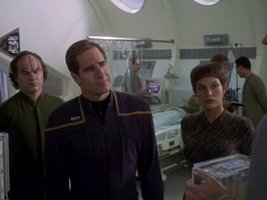
 Would the Prime Directive apply to the Valakians...
Would the Prime Directive apply to the Valakians...